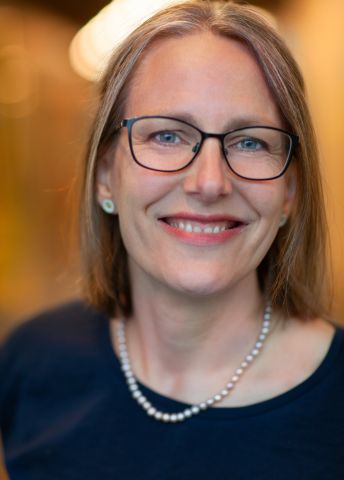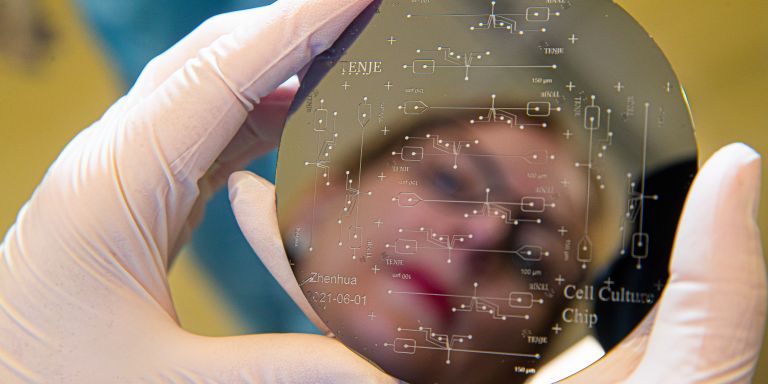
Maria Tenje
Professor of Microsystems Technology
Wallenberg Academy Fellow, prolongation grant 2021
Institution:
Uppsala University
Research field:
Microsystems technology


Wallenberg Academy Fellow, prolongation grant 2021
Institution:
Uppsala University
Research field:
Microsystems technology
Ever since the 1960s researchers have tried to create cell-based models of various organs, known as “organoids”. Major strides have been made in recent decades, but so far a great deal of manual work has been needed to build the cells into organs, which must then survive in tiny wells or on plastic surfaces.
“We need more structure in the various stages of the process. We can use microfluidics to create organoids that are identical every time, with a precise number of cells. Systematic checks and control will open the way for better results from cancer research,” Tenje says.
Organoids are essentially minute living clumps of cells that develop from stem cells. Stem cells can be controlled so they develop into a wide variety of other cells – from liver cells to neurons. This enables the organoids to form tiny models of human organs. These can then be used in research to study both bacterial and viral attacks, and to test new drugs.
Tenje’s goal is to contribute to a more systematic development of organoids mimicking the brain. Her interest in brain models was awakened when she came across them at the University of Copenhagen in a project aiming to develop a model of the blood-brain barrier. The barrier is the body’s way of protecting the brain from harmful substances in the bloodstream, but also acts as an unwelcome obstacle to the transport of drugs to the brain to treat a brain tumor, for example.
“I was attracted by the huge challenges posed by the blood-brain barrier, as well as the fact that this was a field in which, as a technical researcher, I could make a definite contribution in the life sciences field. But those involved in the project also made it clear that a model of the brain was the ultimate goal,” she says.
With the help of the funding she has received as a Wallenberg Academy Fellow, she has put together a research team with highly varied but complementary competencies. Her team includes specialists in microfluidics, biotechnology and medical technology. They are working together to build a platform that will facilitate the development of organoids comprised of neurons – “minibrains” in other words.
One of the problems with current organoids is how to supply the cells in the middle of the miniorgan with nutrients.
“We’re using a special hydrogel to achieve more structured control of neuron development. We can then create channels in the hydrogel that resemble blood vessels in the brain. This will enable us to insert the nutrients and growth factors needed in a controlled manner,” Tenje explains.
The hydrogel is a key component in imitating the cells’ natural environment. It consists of a polymer that is about 98 percent water, in which the cells can grow as freely as they do in the body. A specific number of stem cells are added to a droplet of hydrogel. The cells are then pushed into a single unit with the help of the acoustic forces.
“This allows them to grow together in contact only with each other. We then move them to a microfluidal platform in which we have created a network of soft channels that they can continue to grow around, and that can perform the function of natural blood vessels.”
The channels are created using as 3D printing technology known as “two-photon polymerization”. The technology enables the scientists to create a network of free structures or channels inside a hydrogel, and was refined as part of the earlier blood-brain barrier project.
But a number of challenges have to be overcome before identical minibrains can develop in Tenje’s lab. Will it be possible to push the cells into place without damaging them, or will their biology be affected by the ultrasound? And is it even technically possible to stitch everything together to create a working platform?
“This is a research project with a high risk of failure. But even if we do fail, we’ll have learnt a great deal along the way. No one has done anything like it before, and that’s the kind of challenge I like. And another major driving force is the prospect of eventually being able to make a difference to people suffering from brain cancer.”
“The Wallenberg Academy Fellow scheme gives researchers a fantastic network, which both inspires and enables us to use real expert knowledge to achieve progress.”
A further challenge she faces is to find ways of studying the growing minibrains. A nascent collaboration with researchers at UC Santa Barbara in California may play a decisive role. The researchers there are developing a microscopy technique that makes it possible to image and monitor cell growth inside the hydrogel to see how the internal structures are impacted over time.
Lab-grown brains are not uncommon in works of science fiction. One example is PC Jersild’s book “A Living Soul”, in which a human brain is kept alive floating in a nutrient solution. According to Tenje, it is not beyond the bounds of possibility that a brain could be kept alive in this way:
“We’ll get there one day, which is why it’s essential to discuss the ethical dimensions even now. After all, the cells we’re using also come from a real person – something it’s important for us to acknowledge,” she says.
Text Magnus Trogen Pahlén
Translation Maxwell Arding
Photo Magnus Bergström